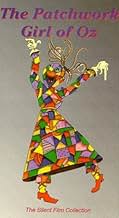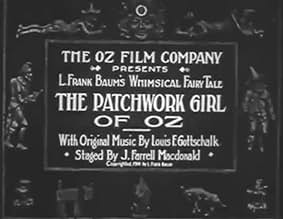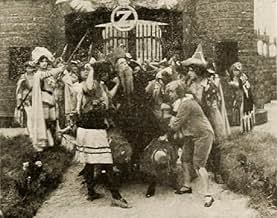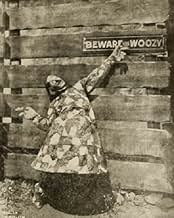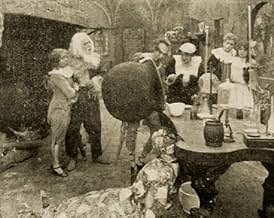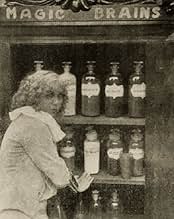Ojo and Unc Nunkie are out of food, so they decide to journey to the Emerald City where they will never starve.Ojo and Unc Nunkie are out of food, so they decide to journey to the Emerald City where they will never starve.Ojo and Unc Nunkie are out of food, so they decide to journey to the Emerald City where they will never starve.
Leontine Dranet
- Margolotte, his wife, who makes the Patchwork Girl
- (as Haras Dranet)
Richard Rosson
- Danx, a Noble Munchkin
- (as Dick Rosson)
Bert Glennon
- The Scarecrow
- (as Herbert Glennon)
Hal Roach
- The Cowardly Lion
- (as Al Roach)
- …
Dave Anderson
- The Hungry Tiger
- (as Andy Anderson)
Pierre Couderc
- Scraps, the Patchwork Girl
- (as The Marvelous Couderc)
Featured reviews
Quite an enjoyable movie. I'd seen it twice before (in the Origins of Film box set), and watched it again with my grandmother who was born the year it was released. L. Frank Baum produced, and was evidently on the set with the director.
A young boy named Ojo (played by a woman) lives with his Unc Nunkie, and they've run out of food. They decide to go to Oz, where there is always more than enough food.
On the way, they encounter a wizard who's been working on a potion for six years to create life. His wife, using a magic wand, assembles a human-size patchwork doll to use the potion on. It won't have brains, since that makes for better servants says the wife. Ojo decides to mix up some magic brains and surreptitiously put them in, however. After the Patchwork Girl (played by a man) is brought to life, there's an accident that results in the wizard's wife, Unc Nunkie, and the Munchkin lover of the wizard's daughter being petrified. Munchkins in this film are not little people, though they do wear different costumes.
Ojo, the Patchwork Girl, the wizard, his daughter and her friends must go out to collect ingredients for an antidote: three hairs from a Woozy's tail, a six-leaved clover, and a gill of water from a Dark Well. The daughter has her father shrink her petrified boyfriend down to doll size, since she can't be without him.
On the way, they meet one-legged Hoppers, tribal Tottenhots, and jolly Horners. They encounter a maid of Oz who helps them, but who also develops a liking for the petrified Munchkin.
The sets are simple, yet nicely establish a fantasy world. Costumes are good too. The wizard character is stooped and knock-kneed (possibly from stirring a potion for six years with his hands *and* legs?). The Woozy is neat, a big boxy cat played by Fred Woodward, who specialized in animal roles (he does several others in this movie). Despite being a simple costume, it seems more real than some CGI creations.
The Wizard of Oz, the Tin Man, the Scarecrow, and the Cowardly Lion show up towards the end. The original mission to obtain food is forgotten by that point!
It's a cute movie, and I suspect that despite being silent (with musical score added) and black and white, and ninety-one years old that it would still delight small children.
A young boy named Ojo (played by a woman) lives with his Unc Nunkie, and they've run out of food. They decide to go to Oz, where there is always more than enough food.
On the way, they encounter a wizard who's been working on a potion for six years to create life. His wife, using a magic wand, assembles a human-size patchwork doll to use the potion on. It won't have brains, since that makes for better servants says the wife. Ojo decides to mix up some magic brains and surreptitiously put them in, however. After the Patchwork Girl (played by a man) is brought to life, there's an accident that results in the wizard's wife, Unc Nunkie, and the Munchkin lover of the wizard's daughter being petrified. Munchkins in this film are not little people, though they do wear different costumes.
Ojo, the Patchwork Girl, the wizard, his daughter and her friends must go out to collect ingredients for an antidote: three hairs from a Woozy's tail, a six-leaved clover, and a gill of water from a Dark Well. The daughter has her father shrink her petrified boyfriend down to doll size, since she can't be without him.
On the way, they meet one-legged Hoppers, tribal Tottenhots, and jolly Horners. They encounter a maid of Oz who helps them, but who also develops a liking for the petrified Munchkin.
The sets are simple, yet nicely establish a fantasy world. Costumes are good too. The wizard character is stooped and knock-kneed (possibly from stirring a potion for six years with his hands *and* legs?). The Woozy is neat, a big boxy cat played by Fred Woodward, who specialized in animal roles (he does several others in this movie). Despite being a simple costume, it seems more real than some CGI creations.
The Wizard of Oz, the Tin Man, the Scarecrow, and the Cowardly Lion show up towards the end. The original mission to obtain food is forgotten by that point!
It's a cute movie, and I suspect that despite being silent (with musical score added) and black and white, and ninety-one years old that it would still delight small children.
A young munchkin named Ojo (played by Violet MacMillan) and her Unc Nunkie decide to set out in search of a better life in the Emerald City of Oz. Along the way, they meet and befriend a magician and his family. The magician has long been at work on perfecting a magic powder of life, his wife having created a patchwork servant girl whom they hope to bring to life. Things go awry when the newly awakened patchwork girl accidentally spills a petrification fluid upon the Magician's wife and his future son in-law as well as Ojo's Unc Nunkie. Now our heroes (the Patchwork Girl, Ojo, the Magician and his daughter) must combine forces in search of the different, rare and hard to obtain ingredients necessary for a spell to undo the petrification process. Many unusual adventures, magical as only the world of Oz can be, await.
This delightful flight of fancy provides viewers with a fun escape from reality. The actors and actresses breathe such a wonderfully vibrant energy into their lively performances that they prove quite a joy to watch. Basically this starts off as a series of individual stories focused on a wide number of colorful characters. By the film's end however, all these different characters and their individual stories seem to merge together into one near epic tale. Of the three 1914 Oz film produced in part by L. Frank Baum himself, this one is clearly the best and most complete adventure story.
This delightful flight of fancy provides viewers with a fun escape from reality. The actors and actresses breathe such a wonderfully vibrant energy into their lively performances that they prove quite a joy to watch. Basically this starts off as a series of individual stories focused on a wide number of colorful characters. By the film's end however, all these different characters and their individual stories seem to merge together into one near epic tale. Of the three 1914 Oz film produced in part by L. Frank Baum himself, this one is clearly the best and most complete adventure story.
You really have to look at "The Patchwork Girl of Oz" in context, otherwise you'll just dismiss it as a dull and incomprehensible movie. But, back in 1914, it was a rather impressive tale--but one that even audiences back then probably struggled to understand unless they'd read the Frank Baum story. Heck, I tried watching it was was TOTALLY confused until I read a summary of the story on the internet! That's because the narrative is really scant--with almost no intertitle cards. Instead, it's shown as a series of tenuously connected vignettes which are described on the card and then acted out...as was the style up until about 1914 or a bit later. It comes off almost like a slide show that is acted out for the audience! This certainly is NOT all that entertaining and too often the characters just cavort about aimlessly or do acrobatics instead of acting--and it comes off pretty poorly. BUT, again, it was pretty much the style of the day. The ladies in the film and sets and 'magic' were pretty similar to the work done a decade earlier by the groundbreaking French film maker Georges Méliès. By 1914, these amazing effects and story telling really were a a bit passé--definitely on their way out--which might explain why the film was a critical flop--that, and the fact that the audience probably had no idea what was occurring on screen! Interesting from a historical perspective and having excellent production values for the time, but still very easy to skip unless you adore very early silent films.
As a child, The Patchwork Girl of Oz was my favorite Oz book. This silent film version is a charming look at how Oz was envisioned by it's creator--L. Frank Baum produced the film. The story however does stray from the book and some of the scenes are a bit disjointed. Motion pictures were in their infancy in 1914--most films were stagebound dramas, so to see a fantasy film from this period is unique.
The Patchwork Girl or "Scraps" is played by French acrobat Pierre Couderc. The part where Scraps catches the eye of the Scarecrow is very amusing. Also, the Yoop character is a forerunner to the Winged Monkeys who terrorized Judy Garland 25 years later.
In the video version I saw, the pivotal scene where Scraps is brought to life and tips over the Liquid of Petrification, is missing or destroyed--but the rest of the film is intact however.
The Patchwork Girl or "Scraps" is played by French acrobat Pierre Couderc. The part where Scraps catches the eye of the Scarecrow is very amusing. Also, the Yoop character is a forerunner to the Winged Monkeys who terrorized Judy Garland 25 years later.
In the video version I saw, the pivotal scene where Scraps is brought to life and tips over the Liquid of Petrification, is missing or destroyed--but the rest of the film is intact however.
The recent phenomenon of Harry Potter isn't so unusual. An early case it the amazing popularity of Oz.
The books, the first ones, became popular, amazingly so. By some measures more popular than Potter. They are simple: children, a magical land rather a land like ours in many ways but with magic and magical creatures.
Then the movies started. Magic sells cinematically when the world is like the one we live in plus magic that matches what the camera can emulate. When the writer understands the overlap, he or she can write books that are cinematically rooted. Each feeds the other. Each feeds the juvenile imagination.
You should watch this. Because with distance, you can see how shallow that imagination is. The effects of today's movies are better, but they are no less believable to us than these were in their day. Let that soak in and you'll get pretty depressed about the current Potter phenomenon (and probably increase your appreciation for the "Rings" works).
Ted's Evaluation -- 2 of 3: Has some interesting elements.
The books, the first ones, became popular, amazingly so. By some measures more popular than Potter. They are simple: children, a magical land rather a land like ours in many ways but with magic and magical creatures.
Then the movies started. Magic sells cinematically when the world is like the one we live in plus magic that matches what the camera can emulate. When the writer understands the overlap, he or she can write books that are cinematically rooted. Each feeds the other. Each feeds the juvenile imagination.
You should watch this. Because with distance, you can see how shallow that imagination is. The effects of today's movies are better, but they are no less believable to us than these were in their day. Let that soak in and you'll get pretty depressed about the current Potter phenomenon (and probably increase your appreciation for the "Rings" works).
Ted's Evaluation -- 2 of 3: Has some interesting elements.
Did you know
- TriviaHarold Lloyd and Hal Roach, who both have minor roles in this film, met on this set in San Diego. Roach was impressed by Lloyd's energy and sought him out when he formed his production company The Rolin Film Company in July 1914 after receiving a small inheritance. Although their association was stormy, their association was ultimately one of the most successful in silent film history.
- GoofsThe character of Ojo is stated several times to be a boy, but is referred to as a girl in one of the dialogue caption cards.
- ConnectionsFeatured in American Masters: Harold Lloyd: The Third Genius (1989)
- How long is The Patchwork Girl of Oz?Powered by Alexa
Details
- Runtime1 hour 21 minutes
- Color
- Sound mix
- Aspect ratio
- 1.33 : 1
Contribute to this page
Suggest an edit or add missing content

Top Gap
By what name was The Patchwork Girl of Oz (1914) officially released in Canada in English?
Answer


